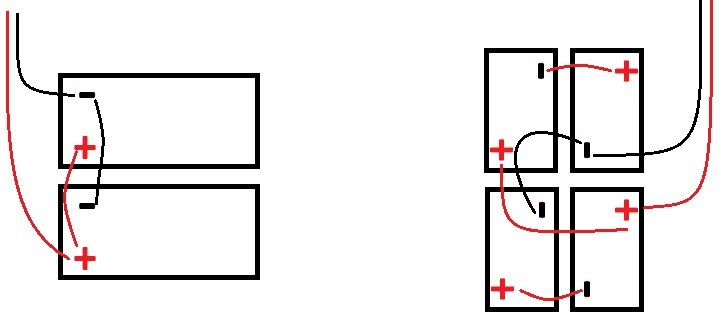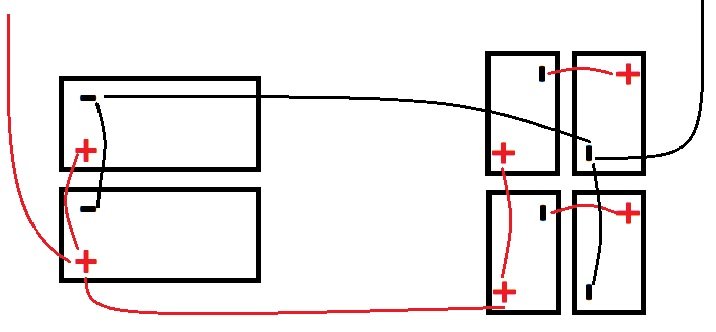dhays
Guru
- Joined
- May 26, 2015
- Messages
- 9,045
- Location
- United States
- Vessel Name
- Kinship
- Vessel Make
- North Pacific 43
Another little fly in the ointment....
My plan at the moment is to combine the two banks (thruster and house) into one bank when I have the new house bank in place. As I've fretted about before, it isn't ideal to combine a bank of older Lifeline 255 Ah batteries with a bank of new AGM 6v batteries.
Since the boat was setup with those two separate banks, each bank goes to its own pos buss bar. I can connect those two buss bars with a short 4/0 link cable (tested it and it works just fine). I understand that each bank will likely have slightly different amp draws given differences in the number of connects, chemistry, and age.
Today as I was staring yet again at the DC board in the aft lazarette I hit upon a problem with that setup. I have a Xantrex Linklite battery monitor on the boat. The house bank neg cable goes to the 500A x 50mv ground shunt which the Xantrex Linklite is connected to. This is able to measure all the loads on the house bank. However, if I cross connect the two bank at their positive buss bars, this will not measure the current being supplied by the Thruster bank since its neg cable doesn't connect to the shunt.
So, while simply combining the two banks works, it will leave me blind as far as the amount of current used. I am guessing that if I moved the ground connection from the thruster bank to the shunt (same terminal as the house bank) that it would solve that problem, but that means buying another 4/0 cable for the thruster ground and running it to the shunt. The current cable is not long enough to reach. I could kludge something together and add another short link to make it reach, but that would simply add yet another connection in an already long cable.
Two other solutions. The first would be to actually parallel all the batteries together into one true bank instead of just combining them with a link at the pos buss bars. The downside to this is that it would make it harder to separate the banks in the future. Now it would just be a matter of disconnecting that one link between the two positive bus bars and the the banks are once again completely separate. Another issues is that I'm paralleling different size and ages of batteries. The other issue is that it would mean adding a very long parallel link between the two banks. When all is said and done it would likely be 8' of 4/0. That will have a larger resistance than the other links. However, I found a way to make all the batteries see the same resistance from the links. This solves the Linklite problem because the ground for all the batteries would go to the existing shunt.
The other solution would be to parallel the batteries as above but install a Balmar Smartgauge instead of the Xantrex Linklite. I could then get rid of the shunt and its myriad connections. The downside here is the installation of the Smartgauge. It is easy to wire up, but it would be a real pain to run new wire from the aft lazarette to the PH and cut a new (and large) hole in the PH control station. One thing I don't know how to do is to wire the alarm relay that will cut out the inverter at a given SOC%. The Xantrex is currently wired to do it and I know the Smartgauge can, I just haven't figure out the Xantrex is wired to do that yet.
The more I learn, the more I realize how utterly ignorant I am.
My plan at the moment is to combine the two banks (thruster and house) into one bank when I have the new house bank in place. As I've fretted about before, it isn't ideal to combine a bank of older Lifeline 255 Ah batteries with a bank of new AGM 6v batteries.
Since the boat was setup with those two separate banks, each bank goes to its own pos buss bar. I can connect those two buss bars with a short 4/0 link cable (tested it and it works just fine). I understand that each bank will likely have slightly different amp draws given differences in the number of connects, chemistry, and age.
Today as I was staring yet again at the DC board in the aft lazarette I hit upon a problem with that setup. I have a Xantrex Linklite battery monitor on the boat. The house bank neg cable goes to the 500A x 50mv ground shunt which the Xantrex Linklite is connected to. This is able to measure all the loads on the house bank. However, if I cross connect the two bank at their positive buss bars, this will not measure the current being supplied by the Thruster bank since its neg cable doesn't connect to the shunt.
So, while simply combining the two banks works, it will leave me blind as far as the amount of current used. I am guessing that if I moved the ground connection from the thruster bank to the shunt (same terminal as the house bank) that it would solve that problem, but that means buying another 4/0 cable for the thruster ground and running it to the shunt. The current cable is not long enough to reach. I could kludge something together and add another short link to make it reach, but that would simply add yet another connection in an already long cable.
Two other solutions. The first would be to actually parallel all the batteries together into one true bank instead of just combining them with a link at the pos buss bars. The downside to this is that it would make it harder to separate the banks in the future. Now it would just be a matter of disconnecting that one link between the two positive bus bars and the the banks are once again completely separate. Another issues is that I'm paralleling different size and ages of batteries. The other issue is that it would mean adding a very long parallel link between the two banks. When all is said and done it would likely be 8' of 4/0. That will have a larger resistance than the other links. However, I found a way to make all the batteries see the same resistance from the links. This solves the Linklite problem because the ground for all the batteries would go to the existing shunt.
The other solution would be to parallel the batteries as above but install a Balmar Smartgauge instead of the Xantrex Linklite. I could then get rid of the shunt and its myriad connections. The downside here is the installation of the Smartgauge. It is easy to wire up, but it would be a real pain to run new wire from the aft lazarette to the PH and cut a new (and large) hole in the PH control station. One thing I don't know how to do is to wire the alarm relay that will cut out the inverter at a given SOC%. The Xantrex is currently wired to do it and I know the Smartgauge can, I just haven't figure out the Xantrex is wired to do that yet.
The more I learn, the more I realize how utterly ignorant I am.





